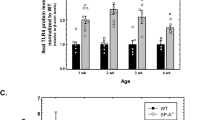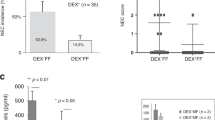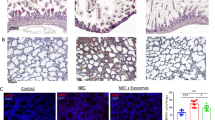Abstract
Purpose
Necrotizing enterocolitis (NEC) is a devastating inflammatory disease of preterm infants that may depend on overexpression of toll-like receptor-4 (TLR4) in the immature intestine. Surfactant protein (SP)-D is a member of the collectin family and plays an important role in innate immunity, particularly in the airways. Although SP-D also exists in the intestines, little is known about its function. This study investigated whether SP-D can attenuate the inflammatory response of TLR4-overexpressing embryonal intestinal cells.
Methods
All experimental procedures were performed using the human intestinal cell line INT407 originally derived from human embryonal intestines. Platelet-activating factor (PAF), reported to be elevated in NEC patients, was used to induce TLR4 overexpression in the human embryonal intestinal cell line INT407. TLR4 expression was measured using quantitative real-time PCR. Inflammatory responses to PAF (5 µM), the TLR4 agonist lipopolysaccharide (LPS, 100 ng/ml), PAF + LPS, and PAF + LPS following SP-D pretreatment (20 µg/ml) were assessed by enzyme-linked immunosorbent assay (ELISA) of interleukin-8 (IL-8) release (in pg/ml).
Results
Expression of TLR4 mRNA (mean ± SD) was upregulated by PAF (369 % ± 28 %, p < 0.001). Stimulation with PAF + LPS resulted in higher IL-8 release (1959.3 ± 52.3) than control (141.2 ± 12.4), LPS (167.3 ± 65.8), or PAF (1527.2 ± 129.4) treatment (p < 0.05). Release in response to PAF + LPS (1590.1 ± 319.3) was attenuated by SP-D pretreatment (1161.6 ± 131.6; p < 0.05).
Conclusion
SP-D attenuates LPS-induced IL-8 production in TLR4-overexpressing intestinal cells, suggesting that SP-D may have a protective effect in the development of NEC in preterm infants.



Similar content being viewed by others
References
Neu J, Walker WA (2011) Necrotizing enterocolitis. N Engl J Med 364:255–264. doi:10.1056/NEJMra1005408
Afrazi A, Sodhi CP, Richardson W et al (2011) New insights into the pathogenesis and treatment of necrotizing enterocolitis: toll-like receptors and beyond. Pediatr Res 69:183–188. doi:10.1203/PDR.0b013e3182093280
Good M, Siggers R, Sodhi C et al (2012) Amniotic fluid inhibits Toll-like receptor 4 signaling in the fetal and neonatal intestinal epithelium. Proc Natl Acad Sci USA 109(28):11330–11335. doi:10.1073/pnas.1200856109
Fusunyan RD, Nanthakumar NN, Baldeon ME, Walker WA (2001) Evidence for an innate immune response in the immature human intestine: toll-like receptors on fetal enterocytes. Pediatr Res 49:589–593. doi:10.1203/00006450-200105000-00006
Leaphart CL, Cavallo J, Gribar SC et al (2007) A critical role for TLR4 in the pathogenesis of necrotizing enterocolitis by modulating intestinal injury and repair. J Immunol 179:4808–4820. doi:10.4049/jimmunol.179.7.4808
Hackam DJ, Afrazi A, Good M, Sodhi CP (2013) Innate immune signaling in the pathogenesis of necrotizing enterocolitis. Clin Dev Immunol 2013:475415. doi:10.1155/2013/475415
Sun XM, Hsueh W (1988) Bowel necrosis induced by tumor necrosis factor in rats is mediated by platelet-activating factor. J Clin Invest 81:1328–1331. doi:10.1172/JCI113459
Soliman A, Michelsen KS, Karahashi H et al (2010) Platelet-activating factor induces TLR4 expression in intestinal epithelial cells: implication for the pathogenesis of necrotizing enterocolitis. PLoS One 5:e15044. doi:10.1371/journal.pone.0015044
Frost BL, Jilling T, Caplan MS (2008) The importance of pro-inflammatory signaling in neonatal necrotizing enterocolitis. Semin Perinatol 32:100–106. doi:10.1053/j.semperi.2008.01.001
Wright JR (1997) Immunomodulatory functions of surfactant. Physiol Rev 77:931–962
Stahlman MT, Gray ME, Hull WM, Whitsett JA (2002) Immunolocalization of surfactant protein-D (SP-D) in human fetal, newborn, and adult tissues. J Histochem Cytochem 50:651–660. doi:10.1177/002215540205000506
Saka R, Yanagihara I, Sasaki T et al (2015) Immunolocalization of surfactant protein D in the liver from infants with cholestatic liver disease. J Pediatr Surg 50:297–300. doi:10.1016/j.jpedsurg.2014.11.020
Saka R, Okuyama H, Uchida K et al (2014) The expression of surfactant proteins A and D in the intestines and pancreas of murine fetuses. Open J Pediatr 4:12–20
Yamazoe M, Nishitani C, Takahashi M et al (2008) Pulmonary surfactant protein D inhibits lipopolysaccharide (LPS)-induced inflammatory cell responses by altering LPS binding to its receptors. J Biol Chem 283:35878–35888. doi:10.1074/jbc.M807268200
Verhoeff-Bakkenes L, Hazeleger WC, Zwietering MH, De Jonge R (2008) Lack of response of INT-407 cells to the presence of non-culturable Campylobacter jejuni. Epidemiol Infect 136:1401–1406. doi:10.1017/S0950268807000040
Chan K, Wong K, Luk J (2009) Role of LPS/CD14/TLR4-mediated inflammation in necrotizing enterocolitis: pathogenesis and therapeutic implications. World J Gastroenterol WJG 15:4745–4752. doi:10.3748/wjg.15.4745
Jilling T, Simon D, Lu J, Meng F (2006) The roles of bacteria and TLR4 in rat and murine models of necrotizing enterocolitis. J Immunol 177:3273–3282
Tanner SM, Berryhill TF, Ellenburg JL et al (2015) Pathogenesis of necrotizing enterocolitis. Am J Pathol 185:4–16. doi:10.1016/j.ajpath.2014.08.028
Wang H, Tan X, Chang H et al (1997) Regulation of platelet-activating factor receptor gene expression in vivo by endotoxin, platelet-activating factor and endogenous tumour necrosis factor. Biochem J 322(Pt 2):603–608
Borthakur A, Bhattacharyya S, Alrefai WA et al (2010) Platelet-activating factor-induced NF-kappaB activation and IL-8 production in intestinal epithelial cells are Bcl10-dependent. Inflamm Bowel Dis 16:593–603. doi:10.1002/ibd.21092
Honda Z, Ishii S, Shimizu T (2002) Platelet-activating factor receptor. J Biochem 779:773–779
Amer MD, Hedlund E, Rochester J, Caplan MS (2004) Platelet-activating factor concentration in the stool of human newborns: effects of enteral feeding and neonatal necrotizing enterocolitis. Biol Neonat 85:159–166. doi:10.1159/000075306
Lotz M, Gütle D, Walther S et al (2006) Postnatal acquisition of endotoxin tolerance in intestinal epithelial cells. J Exp Med 203:973–984. doi:10.1084/jem.20050625
Naik S, Kelly EJ, Meijer L et al (2001) Absence of Toll-like receptor 4 explains endotoxin hyporesponsiveness in human intestinal epithelium. J Pediatr Gastroenterol Nutr 32:449–453
Benkoe T, Baumann S, Weninger M et al (2013) Comprehensive evaluation of 11 cytokines in premature infants with surgical necrotizing enterocolitis. PLoS One 8:e58720. doi:10.1371/journal.pone.0058720
Edelson M, Bagwell C, Rozycki H (1999) Circulating pro-and counterinflammatory cytokine levels and severity in necrotizing enterocolitis. Pediatrics 103:766–771
Benkoe T, Reck C, Gleiss A et al (2012) Interleukin 8 correlates with intestinal involvement in surgically treated infants with necrotizing enterocolitis. J Pediatr Surg 47:1548–1554. doi:10.1016/j.jpedsurg.2011.11.049
Akira S (2003) Toll-like receptor signaling. J Biol Chem 278:38105–38108. doi:10.1074/jbc.R300028200
He W, Qu T, Yu Q et al (2013) LPS induces IL-8 expression through TLR4, MyD88, NF-kappaB and MAPK pathways in human dental pulp stem cells. Int Endod J 46:128–136. doi:10.1111/j.1365-2591.2012.02096.x
Sano H, Kuroki Y (2005) The lung collectins, SP-A and SP-D, modulate pulmonary innate immunity. Mol Immunol 42:279–287. doi:10.1016/j.molimm.2004.07.014
Kuroki Y, Takahashi M, Nishitani C (2007) Pulmonary collectins in innate immunity of the lung. Cell Microbiol 9:1871–1879. doi:10.1111/j.1462-5822.2007.00953.x
Acknowledgments
This study was supported by research grants from the Ministry of Education, Culture, Sports, Science and Technology (MEXT) of Japan (to FN, IY, and HO).
Author information
Authors and Affiliations
Corresponding author
Ethics declarations
Conflicts of interest
The authors declare that they have no conflicts of interest.
Rights and permissions
About this article
Cite this article
Saka, R., Wakimoto, T., Nishiumi, F. et al. Surfactant protein-D attenuates the lipopolysaccharide-induced inflammation in human intestinal cells overexpressing toll-like receptor 4. Pediatr Surg Int 32, 59–63 (2016). https://doi.org/10.1007/s00383-015-3812-y
Accepted:
Published:
Issue Date:
DOI: https://doi.org/10.1007/s00383-015-3812-y




